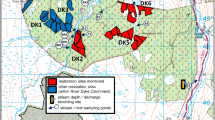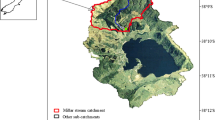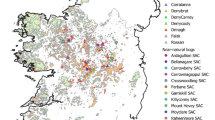Abstract
Few studies have comprehensively measured the effect on water quality of catchment rehabilitation measures in comparison with baseline conditions. Here we have analyzed water clarity and nutrient concentrations and loads for a 13-year period in a headwater catchment within the western Waikato region, New Zealand. For the first 6 years, the entire catchment was used for hill-country cattle and sheep grazing. An integrated catchment management plan was implemented whereby cattle were excluded from riparian areas, the most degraded land was planted in Pinus radiata, channel banks were planted with poplar trees and the beef cattle enterprise was modified. The removal of cattle from riparian areas without additional riparian planting had a positive and rapid effect on stream water clarity. In contrast, the water clarity decreased in those sub-catchments where livestock was excluded but riparian areas were planted with trees and shrubs. We attribute the decrease in water clarity to a reduction in groundcover vegetation that armors stream banks against preparatory erosion processes. Increases in concentrations of forms of P and N were recorded. These increases were attributed to: (i) the reduction of instream nutrient uptake by macrophytes and periphyton due to increased riparian shading; (ii) uncontrolled growth of a nitrogen fixing weed (gorse) in some parts of the catchment, and (iii) the reduction in the nutrient attenuation capacity of seepage wetlands due to the decrease in their areal coverage in response to afforestation. Our findings highlight the complex nature of the water quality response to catchment rehabilitation measures.








Similar content being viewed by others
References
Abernethy B, Rutherfurd ID (1998) Where along a river’s length will vegetation most effectively stabilise stream banks? Geomorphology 23:55–75
Abernethy B, Rutherfurd ID (2000) The effect of riparian tree roots on the mass-stability of riverbanks. Earth Surf Proc Land 25:921–937
Alexander GG, Allan JD (2007) Ecological success in stream restoration: case studies from the midwestern United States. Environ Manag 40:245–255
Alexander RB, Boyer EW, Smith RA, Schwarz GE, Moore RB (2007) The role of headwater streams in downstream water quality. J Am Water Resour Assoc 43:41–59
Anderson RJ, Bledsoe BP, Hession WC (2004) Width of streams and rivers in response to vegetation, bank material, and other factors. J Am Water Resour Assoc 40:1159–1172
ANZECC (2000) Australian and New Zealand Guidelines for Fresh and Marine Water Quality, vol 1. Australian and New Zealand Environment and Conservation Council, Agriculture and Resource Management Council of Australia and New Zealand
Biggs BJF, Thomsen HA (1995) Disturbance of stream periphyton by perturbations in shear stress: time to structural failure and differences in community resistance. J Phycol 31:233–241
Blanco-Canqui H, Gantzer CJ, Anderson SH, Alberts EE, Thompson AL (2004) Grass barrier and vegetative filter strip effectiveness in reducing runoff, sediment, nitrogen, and phosphorus loss. Soil Sci Soc Am J 68:1670–1678
Bukaveckas PA (2007) Effects of channel restoration on water velocity, transient storage, and nutrient uptake in a channelized stream. Environ Sci Technol 41:1570–1576
Burt TP, Matchett LS, Goulding KWT, Webster CP, Haycock NE (1999) Denitrification in riparian buffer zones: the role of foodplain hydrology. Hydrol Process 13:1451–1463
Cox TJ, Rutherford JC (2012) Nitrogen fate and transport in a watercress dominated stream. NZ J Mar Freshwat Res 46:191–205
Davies-Colley RJ (1988) Measuring water clarity with black disk. Limnol Oceanogr 33:616–623
Davies-Colley RJ (1997) Stream channels are narrower in pasture than in forest. NZ J Mar Freshwat Res 31:599–608
Davies-Colley RJ (2000) Trigger values for New Zealand rivers. NIWA Client Report MFE002/22. http://www.mfe.govt.nz/publications/water/trigger-values-rivers-may00/trigger-values-river-may00.pdf. Accessed 9 Sept 2014
Davis M, Coker G, Watt M, Graham D, Pearce S, Dando J (2012) Nitrogen leaching after fertilising young Pinus radiata plantations in New Zealand. For Ecol Manag 280:20–30
Dodd MB, Quinn JM, Thorrold BS, Parminter TG, Wedderburn ME (2008a) Improving the economic and environmental performance of a New Zealand hill country farm catchment: 3. Short term outcomes of land use change. NZ J Agric Res 53:155–169
Dodd MB, Thorrold BS, Quinn JM, Parminter TG, Wedderburn ME (2008b) Improving the economic and environmental performance of a New Zealand hill country farm catchment: 1. Goal development and assessment of current performance. NZ J Agric Res 51:127–141
Dodd MB, Wedderburn ME, Parminter TG, Thorrold BS, Quinn JM (2008c) Transformation toward agricultural sustainability in New Zealand hill country pastoral landscapes. Agric Syst 98:95–107
Dodds WK, Oakes RM (2008) Headwater influences on downstream water quality. Environ Manag 41:367–377
Downes MT, Howard-Williams C, Schipper LA (1997) Long and short roads to riparian zone restoration: Nitrate removal efficiency. In: Haycock NE, Burt TP, Goulding KWT, Pinay G (eds) Buffer zones: their processes and potential in water protection, quest environmental. Oxford, Hardfordshire, p 244
Dyck WJ, Gosz JR, Hodgkiss PD (1983) Nitrate losses from disturbed ecosystems in New Zealand—a comparative analysis. NZ J Forest Sci 13:14–24
Gregersen HM, Ffolliott PF, Brooks KN (2007) Integrated watershed management. Connecting people to their land and water. CABI, Wallingford, p 201
Helsel DR, Hirsch RM (1992) Statistical methods in water resources. Elsevier Science, Amsterdam, p 522
Helsel DR and Hirsch RM (2002) Statistical methods in water resources, vol TWRI Book 4, Chapter A3. United States Geological Survey
Hickey CW and Martin ML (2009) A review of nitrate toxicity to freshwater aquatic species. Environment Canterbury, Christchurch, pp. 56
Hirsch RM, Slack JR, Smith RA (1982) Techniques of trend analysis for monthly water quality data. Water Resour Res 18:107–121
Howard-Williams C and Pickmere S (1999) Nutrient and vegetation changes in a retired pasture stream: recent monitoring in the context of a long-term dataset. Department of Conservation, Wellington, pp. 41
Hughes AO, Quinn JM, McKergow LA (2012) Land use influences on suspended sediment yields and event sediment dynamics within two headwater catchments, Waikato, New Zealand. NZ J Mar Freshwat Res 46:315–333
Lawler DM (1995) The impact of scale on the processes of channel-side sediment supply: a conceptual model. In: Osterkamp WR (ed) Effects of scale on interpretation and management of sediment and water quality. IAHS Publication 226, New York, pp 175–184
Ledgard SF, Brier GJ, Littler RA (1987) Legume production and nitrogen fixation in hill pasture communities. NZ J Agric Res 30:413–421
Lee KH, Isenhart TM, Schultz RC (2003) Sediment and nutrient removal in an established multi-species riparian buffer. J Soil Water Conserv 58:1–8
Letcher RA, Jakeman AJ, Merritt WS, McKee LJ, Eyre BD, Baginska B (1999) Review of techniques to estimate catchment exports. Environment Protection Agency, Sydney, p 110
Liljaniemi P, Vuori K, Tossavainen T, Kotanen J, Haapanen M, Lepistö A et al (2003) Effectiveness of constructed overland flow areas in decreasing diffuse pollution from forest drainages. Environ Manag 32:602–613
Magesan GN and Wang H (2008) Nitrogen leaching from gorse—Final Report. Scion, pp. 16
Magesan GN, Wang H, Clinton PW (2012) Nitrogen cycling in gorse-dominated ecosystems in New Zealand. NZ J Ecol 36:21–28
Matheson FE, Quinn JM, Martin ML (2012) Effects of irradiance on diel and seasonal patterns of nutrient uptake by stream periphyton. Freshw Biol 57:1617–1630
McKergow LA, Weaver DM, Prosser IP, Grayson RB, Reed AEG (2003) Before and after riparian management: sediment and nutrient exports from a small agricultural catchment, Western Australia. J Hydrol 270:253–272
McKergow LA, Prosser IP, Grayson RB, Heiner D (2004) Performance of grass and rainforest riparian buffers in the wet tropics, Far North Queensland. 2 water quality. Aust J Soil Res 42:485–498
Menneer JC, Ledgard SF, Gillingham AG (2004) Land use impacts on nitrogen and phosphorus loss and management options for intervention. AgResearch, Hamilton, p 52
Muenz TK, Golladay SW, Vellidis G, Smith LL (2006) Stream buffer effectiveness in an agriculturally influenced area, southwestern Georgia: responses of water quality, macroinvertebrates, and amphibians. J Environ Qual 35:1924–1938
Preston SD, Bierman VJ, Silliman SE (1989) An evaluation of methods for the estimation of tributary mass loads. Water Resour Res 25:1379–1389
Prosser IP, Hughes AO, Rutherfurd I (2000) Bank erosion of an incised upland channel by subaerial processes: Tasmania, Australia. Earth Surf Proc Land 25:1085–1101
Quinn JM, Stroud MJ (2002) Water quality and sediment and nutrient export from New Zealand hill-land catchments of contrasting land use. NZ J Mar Freshwat Res 36:409–429
Quinn JM, Cooper AB, Stroud MJ, Burrell GP (1997) Shade effects on stream periphyton and invertebrates: an experiment in streamside channels. NZ J Mar Freshwat Res 31:665–683
Quinn JM, Croker GF, Smith BJ, Bellingham MA (2009) Integrated catchment management effects on flow, habitat, instream vegetation and macroinvertebrates in Waikato, New Zealand, hill-country streams. NZ J Mar Freshwat Res 43:775–802
Rutherford JC, Nguyen ML (2004) Nitrate removal in riparian wetlands: interactions between surface flow and soils. J Environ Qual 33:1133–1143
Sabater F, Butturini A, Marti E, Munoz I, Romani A, Wray J et al (2000) Effects of riparian vegetation removal on nutrient retention in a Mediterranean stream. J N Am Benthol Soc 19:609–620
Shah JJF, Dahm CN, Gloss SP, Bernh ES (2007) River and riparian restoration in the Southwest: results of the National River Restoration Science Synthesis Project. Restor Ecol 15:550–562
Shields FD (2009) Do we know enough about controlling sediment to mitigate damage to stream ecosystems? Ecol Eng 35:1727–1733
Small GE, Duff JH, Torres PJ, Pringle CM (2013) Insect emergence as a nitrogen flux in Neotropical streams: comparisons with microbial denitrification across a stream phosphorus gradient. Freshw Sci 32:1178–1187
Smith CM (1992) Riparian afforestation effects on water yields and water quality in pasture catchments. J Environ Qual 21:237–245
Smith DG, McBride GB, Bryers GG, Wisse J, Mink DFJ (1996) Trends in New Zealand’s National River Water Quality Network. NZ J Mar Freshwat Res 30:485–500
Stone KC, Hunt PG, Novak JM, Johnson MH, Watts DR (2000) Flow-proportional, time composited, and grab sample estimation of nitrogen export from an eastern coastal plain watershed. Trans Am Soc Agric Eng 43:281–290
Sutton AJ, Fisher TR, Gustafson AB (2010) Effects of restored stream buffers on water quality in non-tidal streams in the Choptank River Basin. Water Air Soil Pollut 208:101–118
Trimble SW (1997) Stream channel erosion and change resulting from riparian forests. Geology 25:467–469
Walmsley JJ (2002) Framework for measuring sustainable development in catchment systems. Environ Manag 29:195–206
Wigington PJ, Giffith SM, Field JA, Baham JE, Horwath WR, Owen J et al (2003) Nitrate removal effectiveness of a riparian buffer along a small agricultural stream in Western Oregon. J Environ Qual 32:162–170
Wilkinson AG (1999) Poplars and willows for soil erosion control in New Zealand. Biomass Bioenergy 16:263–274
Williamson RB, Smith CM, Cooper AB (1996) Watershed riparian management and its benefits to a eutrophic lake. J Water Resour Plan Manag 122:24–32
Acknowledgments
Thanks to Kerry Costley and Ralph Morse for site set-up, maintenance, and water sample collection, to Margaret Bellingham and Gareth Van Assema for providing hydrological data, and to staff of NIWA’s Hamilton chemistry laboratory for water quality analyses. AgResearch staff provided site access and cooperation throughout the study. This study was part of the Aquatic Rehabilitation Programme funded by the New Zealand Ministry for Business, Innovation and Employment (Contract CO1X1002). The hydrometric stations at the Whatawhata Research Station were funded by the National Water Resources Programme (Contracts C01X0910 and C01X0303). Reviews by Sandy Elliott, Nicole Beck, and two anonymous reviewers improved the manuscript.
Author information
Authors and Affiliations
Corresponding author
Rights and permissions
About this article
Cite this article
Hughes, A.O., Quinn, J.M. Before and After Integrated Catchment Management in a Headwater Catchment: Changes in Water Quality. Environmental Management 54, 1288–1305 (2014). https://doi.org/10.1007/s00267-014-0369-9
Received:
Accepted:
Published:
Issue Date:
DOI: https://doi.org/10.1007/s00267-014-0369-9




